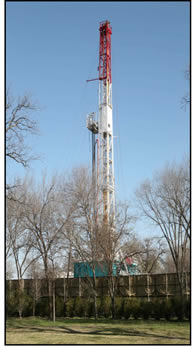Issues
Mount Prospect’s Urban Forest and the Emerald Ash Borer
Walk through a Cook County (Illinois) Forest Preserve, and you will see trees marked with large X’s, indicating that they are to be cut down. Many of the marks are on ash trees infected with the emerald ash borer, or EAB. Since it was first detected in the Detroit area in 2002, this invasive species from Asia has destroyed millions of ash trees throughout the Midwest, including Illinois. Communities throughout the state have acted to stop the spread of the EAB, but progress has been slow, and it is estimated that the EAB has destroyed some 50 million ash trees in the United States. Community efforts have focused on quarantines of firewood, chemical herbicides, and biological enemies. Biologists are experimenting with three species of a Chinese wasp that feed on the larvae of the EAB, but so far, results are inconclusive. In addition, application of herbicide treatments before symptoms appear in a tree has shown some effectiveness in giving a tree longer life.
On April 22, 2014, I spoke about the EAB at the Mount Prospect, Illinois, Public Library. Below are sources that patrons can go to for further information.
- More about Mount Prospect’s urban forest
- Sandy Clark, Forestry/Grounds Superintendent, Village of Mount Prospect, IL, 847-870-5640
- More about Cook County Forest Preserve District
- More about U.S. Forest Service: U.S. Forest Service, “Invasive Species Program”
U.S. Forest Service, National Strategy Implementation Plan for Invasive Species Management (PDF) - Illinois Department of Agriculture
- Openlands
 Fracking: Should We or Shouldn't We?
Fracking: Should We or Shouldn't We?
Over the past several months, I've had the privilege to speak to environmental groups, libraries, and civic organizations throughout the Midwest about the issue of hydraulic fracturing--i.e., fracking. I've been asked to speaking about this topic because Forests for the People has a chapter on tracking in Pennsylvania's Allegheny National Forest. The issue is very hot in the Midwest because energy companies want to start fracking in central and southern Illinois, and mining for the sand used in fracking has come to Minnesota, Wisconsin, and Iowa. Energy companies are also starting to frack in Michigan.
I've had a number of requests to post my Power Point presentation on my website, so here it is. The Power Point has been converted to PDF so that you can see the slides more easily. The entire presentation is titled "Fracking: Should We or Shouldn't We?" and gives pros and cons on the issue. The presentation is divided as follows:
Fracking in Illinois (PDF, 59MB)
Wolves in the Midwest
 In the past few days, I’ve had the chance to speak to environmental groups about the extraordinary recovery of the wolf population in Michigan Wisconsin, and Minnesota. My talk was based on the chapter on wolf recovery and David Govatski’s and my book, Forests for the People. There was a lot of interest in this topic, and especially in the wolf-hunting seasons in the three states. Some background might help understand the events that led to this new edition of an old, old “sport”—hunting for wolves.
In the past few days, I’ve had the chance to speak to environmental groups about the extraordinary recovery of the wolf population in Michigan Wisconsin, and Minnesota. My talk was based on the chapter on wolf recovery and David Govatski’s and my book, Forests for the People. There was a lot of interest in this topic, and especially in the wolf-hunting seasons in the three states. Some background might help understand the events that led to this new edition of an old, old “sport”—hunting for wolves.
At the end of 2011, the U.S. Fish and Wildlife Service delisted the gray wolf from the western Great Lakes region. This decision was based on the recovery of the population since the gray wolf was first listed as an endangered species in 1974, a year after the passage of the Endangered Species Act. Since then, the wolf population has grown to more than 4,000. It’s an amazing story of species recovery, for which the United States Fish and Wildlife Service, the U.S. Forest Service, and conservation groups deserve credit. So do universities like the Michigan Technological University in Houghton, Michigan, which have contributed greatly to our understanding of wolves.
Conservation groups generally praised the delisting action as evidence of wise wildlife policies. Jamie Rapaport Clark, president of Defenders of Wildlife, wrote, “The successful recovery of wolves in the western Great Lakes shows that our nation’s wildlife conservation tools really do work.”
In a press release on July 5, 2011, the National Resources Defense Council wrote, “Fundamentally, NRDC supports the delisting of gray wolves in the Midwest, including in Minnesota, Wisconsin and Michigan.” However, the NRDC warned that the USFWS should consider the wolves in all three states as one large, continuous population, to prevent states from being able to claim that wolf populations as small as 100 can be considered “viable.”
But the re-introduction of a wolf-hunting in Wisconsin, Michigan, and Minnesota have not been received nearly as positively. Conservationists in all three states have come out against the wolf-hunting season, claiming that pro-hunting special interests have played on people’s emotions to push the season through their respective state legislatures. Pat Hallfrisch, who worked as a Unit Manager for Michigan’s Department of Natural Resource before his retirement and continues to live in the Upper Peninsula, told me, “There is still a faction that says that the only good wolf is a dead wolf.”
In a recent editorial, Rolf O. Peterson, a world-renown expert on wolves who is on the faculty at Michigan Technological University, wrote, “Hunt proponents offer reasons that are largely inconsistent with sound science. I’m afraid the real reason has little to do with wolves, but much to do with our collective lack of courage to look inward, to better understand ourselves and our place in nature.” (mlive.com/news/index.ssf/2013/11/michigan_wolf_hunt_rolf_peters.html)
Michigan has set a limit of 43 wolves, out of a population of more than 600. Wisconsin has set a limit of 275, out of a population of more than 800. Minnesota’s limit is 132, out of population of more than 2,200. Wisconsin’s limit in particular seems excessive.
Internet Sites
Here are some sources to learn more about this controversy and how to take action.
Friends of the Wisconsin Wolf: http://www.friendsofthewisconsinwolf.org
Howling for Justice: Blogging for Gray Wolves: http://howlingforjustice.wordpress.com
International Wolf Center: www.wolf.org
Keep Michigan Wolves Protected: www.keepwolvesprotected.com
Predator Defense: www.predatordefense.org/wolves.html
Public Employees for Environmental Responsibility: www.peer.org
U.S. Forest Service: www.fs.fed.us/biology/tes
Books
Here are some books to learn more about wolves. Some are well-known, and some are obscure. All are worth reading.
Jean Craighead George, Julie of the Wolves. (great for kids)
Barry Lopez, Of Wolves and Men
David Mech, Wolf: The Ecology and Behavior of an Endangered Species
L. David Mech and Luigi Boitani (editors), Wolves: Behavior, Ecology, and Conservation
Farley Mowat, Never Cry Wolf. (great for kids and adults)
Rolf O. Peterson, The Wolves of Isle Royale: A Broken Balance.
Adrian Wydeven, Timothy Van Deelen, Edward Heske (editors) Recovery of Gray Wolves in the Great Lakes Region
Chemicals Used in Fracking
I’ve recently spoken to several groups in the Midwest about fracking, as our book Forests for the People looks closely at the issue of fracking on Pennsylvania’s Allegheny National Forest.
One question has come up over and over again: What chemicals are used in the fracking process?
The best source for information on this issue is from a scholarly article that appeared in 2011 in Human and Ecological Risk Assessment: An International Journal. The article is titled “Natural Gas Operations from a Public Health Perspecive” and was co-authored by Theo Colborn, Carol Kwiatkowski, Kim Schultz, and Mary Bachran of The Endocrine Disruption Exchange, a nonprofit organization in Paonia, Colorado, that collects and distributes data about the health and environmental impacts of chemicals. You can access the article online.
Here is a brief summary of the article. To identify the chemicals, the researchers had to use Material Safety Data Sheets, which list components for the workers who are handling the chemicals. The researchers could not learn the composition of the fracturing fluids directly from the oil and gas companies because the 2005 Energy Policy Act exempted hydraulic fracturing from the Safe Drinking Water Act, which would have required that the companies list the chemicals used. The exemption has come to be known as “the Halliburton loophole” because it allowed Halliburton and other companies involved in fracturing to protect the chemical composition of the fracturing fluids as proprietary information. Vice President Dick Cheney, the former CEO of Halliburton, supported the exemption.
Colborn and her associates identified 944 products containing 632 chemicals. The chemicals serve a variety of functions: to improve the injection ability of the fracturing fluids, make water slick to reduce friction and decrease the horsepower needed to generate the enormous pressure needed for fracturing, prevent clogging of soil in the well, improve fluid viscosity, reduce corrosion of pipes and fittings, prevent the plugging of fractures in the shale, and inhibit the buildup of fluids in the pipes.
Of the 632 chemicals that they identified, 70 were chemicals that have had 10 or more adverse health effects. The researchers wrote that “75% of the chemicals on the list can affect the skin, eyes, and other sensory organs, the respiratory system, the gastrointestinal system, and the liver. More than half the chemicals show effects on the brain and nervous system.”
Many of these chemicals are toxic and are cancer-causing agents. They include ammonia, cadmium, ethylbenzene, napthalene, kerosene, diesel fuel, methanol, formaldehyde, ethylene glycol, hydrocholoric acid, sodium hydroxide, and sulfuric acid. All of these chemicals are toxic. Petroleum distillates like kerosene contain benzene, which is a known carcinogen. The chemicals can cause numerous other symptoms, such as stomach cramps, vomiting, dizziness, headaches, asthma, numbness, fainting spells, and convulsions.
In addition when the EPA investigated complaints of ill-smelling water in Pavillion, Wyoming, the agency found the following toxic chemicals: benzene, toluene, ethylbenzene, and xylenes benzene, xylene, gasoline, diesel fuel, and gasoline. This draft report is available online.
Unfortunately, in June 2013, the EPA abandoned its investigation of fracking-related contamination in Pavillion, and further study has been turned over to the state of Wyoming. The research is being funded by EnCana, the company that did the drilling and, therefore, caused this potential contamination. It was extremely important that the EPA complete this investigation, but it will not.